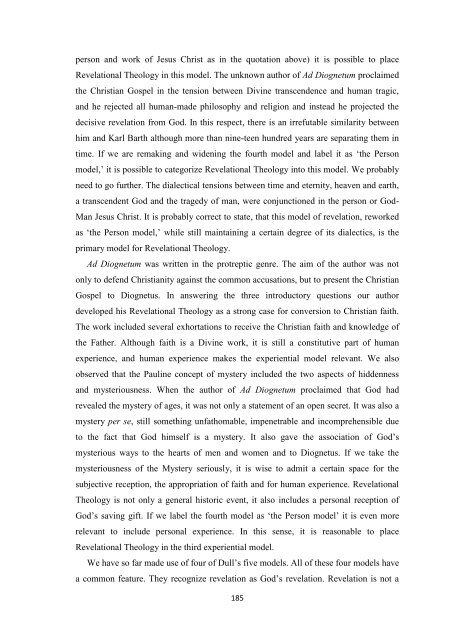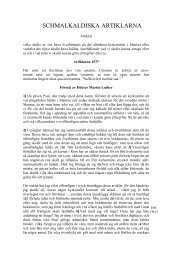MYSTERY REVEALED
MYSTERY REVEALED
MYSTERY REVEALED
Create successful ePaper yourself
Turn your PDF publications into a flip-book with our unique Google optimized e-Paper software.
person and work of Jesus Christ as in the quotation above) it is possible to place<br />
Revelational Theology in this model. The unknown author of Ad Diognetum proclaimed<br />
the Christian Gospel in the tension between Divine transcendence and human tragic,<br />
and he rejected all human-made philosophy and religion and instead he projected the<br />
decisive revelation from God. In this respect, there is an irrefutable similarity between<br />
him and Karl Barth although more than nine-teen hundred years are separating them in<br />
time. If we are remaking and widening the fourth model and label it as ‘the Person<br />
model,’ it is possible to categorize Revelational Theology into this model. We probably<br />
need to go further. The dialectical tensions between time and eternity, heaven and earth,<br />
a transcendent God and the tragedy of man, were conjunctioned in the person or God-<br />
Man Jesus Christ. It is probably correct to state, that this model of revelation, reworked<br />
as ‘the Person model,’ while still maintaining a certain degree of its dialectics, is the<br />
primary model for Revelational Theology.<br />
Ad Diognetum was written in the protreptic genre. The aim of the author was not<br />
only to defend Christianity against the common accusations, but to present the Christian<br />
Gospel to Diognetus. In answering the three introductory questions our author<br />
developed his Revelational Theology as a strong case for conversion to Christian faith.<br />
The work included several exhortations to receive the Christian faith and knowledge of<br />
the Father. Although faith is a Divine work, it is still a constitutive part of human<br />
experience, and human experience makes the experiential model relevant. We also<br />
observed that the Pauline concept of mystery included the two aspects of hiddenness<br />
and mysteriousness. When the author of Ad Diognetum proclaimed that God had<br />
revealed the mystery of ages, it was not only a statement of an open secret. It was also a<br />
mystery per se, still something unfathomable, impenetrable and incomprehensible due<br />
to the fact that God himself is a mystery. It also gave the association of God’s<br />
mysterious ways to the hearts of men and women and to Diognetus. If we take the<br />
mysteriousness of the Mystery seriously, it is wise to admit a certain space for the<br />
subjective reception, the appropriation of faith and for human experience. Revelational<br />
Theology is not only a general historic event, it also includes a personal reception of<br />
God’s saving gift. If we label the fourth model as ‘the Person model’ it is even more<br />
relevant to include personal experience. In this sense, it is reasonable to place<br />
Revelational Theology in the third experiential model.<br />
We have so far made use of four of Dull’s five models. All of these four models have<br />
a common feature. They recognize revelation as God’s revelation. Revelation is not a<br />
185



